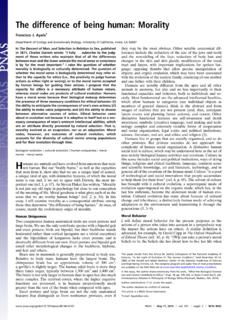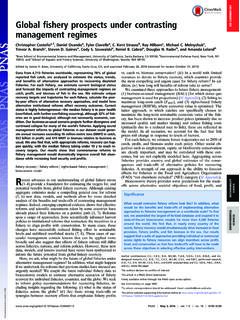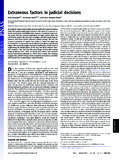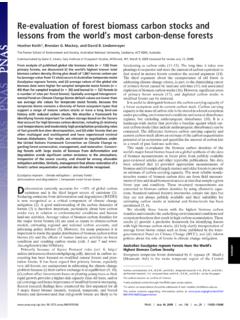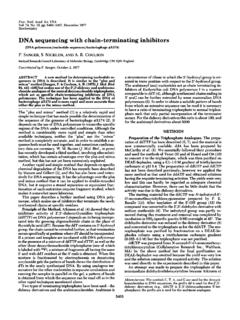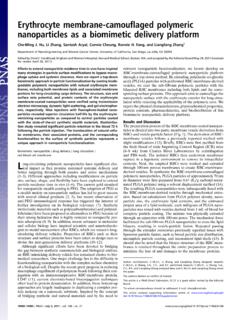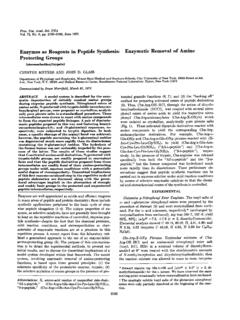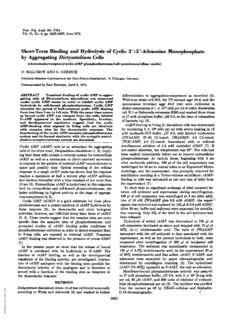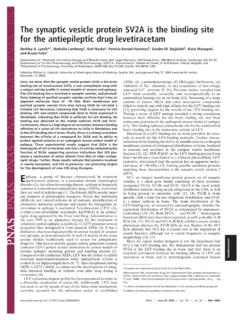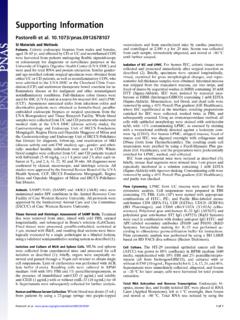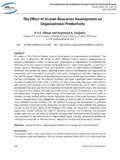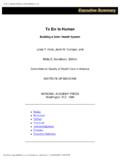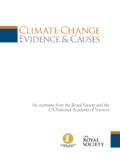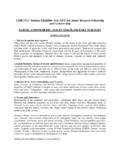Transcription of Bodily maps of emotions - pnas.org
1 Bodily maps of emotionsLauri Nummenmaaa,b,c,1, Enrico Glereana, Riitta Harib,1, and Jari K. HietanendaDepartment of Biomedical Engineering and Computational Science andbBrain Research Unit, O. V. Lounasmaa Laboratory, School of Science, AaltoUniversity, FI-00076, Espoo, Finland;cTurku PET Centre, University of Turku, FI-20521, Turku, Finland; anddHuman Information Processing Laboratory, Schoolof Social Sciences and Humanities, University of Tampere, FI-33014, Tampere, FinlandContributed by Riitta Hari, November 27, 2013 (sent for review June 11, 2013) emotions are often felt in the body, and somatosensory feedbackhas been proposed to trigger conscious emotional we reveal maps of Bodily sensations associated with differentemotions using a unique topographical self-report method.
2 In fiveexperiments, participants (n=701) were shown two silhouettes ofbodies alongside emotional words, stories, movies, or facial expres-sions. They were asked to color the Bodily regions whose activitythey felt increasing or decreasing while viewing each emotions were consistently associated with statisticallyseparable Bodily sensation maps across experiments. These mapswere concordant across West European and East Asian classifiers distinguished emotion-specific activation mapsaccurately, confirming independence of topographies across emo-tions.
3 We propose that emotions are represented in the somatosen-sory system as culturally universal categorical somatotopic of these emotion-triggered Bodily changes may playa key role in generating consciously felt |feelings|somatosensationWe often experience emotions directly in the body. Whenstrolling through the park to meet with our sweetheart wewalk lightly with our hearts pounding with excitement, whereasanxiety might tighten our muscles and make our hands sweat andtremble before an important job interview. Numerous studieshave established that emotion systems prepare us to meet chal-lenges encountered in the environment by adjusting the activa-tion of the cardiovascular, skeletomuscular, neuroendocrine, andautonomic nervous system (ANS) (1).
4 This link between emo-tions and Bodily states is also reflected in the way we speak ofemotions (2): a young bride getting married next week maysuddenly have cold feet, severely disappointed lovers may be heartbroken, and our favorite song may send a shiver downour spine. Both classic (3) and more recent (4, 5) models of emotionalprocessing assume that subjective emotional feelings are trig-gered by the perception of emotion-related Bodily states thatreflect changes in the skeletomuscular, neuroendocrine, and auto-nomic nervous systems (1).
5 These conscious feelings help theindividuals to voluntarily fine-tune their behavior to better matchthe challenges of the environment (6). Although emotions areassociated with a broad range of physiological changes (1, 7), it isstill hotly debated whether the Bodily changes associated withdifferent emotions are specific enough to serve as the basis fordiscrete emotional feelings, such as anger, fear, or happiness(8, 9), and the topographical distribution of the emotion-relatedbodily sensations has remained we reveal maps of Bodily sensations associated with dif-ferent emotions using a unique computer-based, topographicalself-report method (emBODY, Fig.)
6 1). Participants (n=701) wereshown two silhouettes of bodies alongside emotional words,stories, movies, or facial expressions, and they were asked tocolor the Bodily regions whose activity they felt to be increased ordecreased during viewing of each stimulus. Different emotionswere associated with statistically clearly separable Bodily sensa-tion maps (BSMs) that were consistent across West European(Finnish and Swedish) and East Asian (Taiwanese) samples, allspeaking their respective languages. Statistical classifiers dis-criminated emotion-specific activation maps accurately, confirmingindependence of Bodily topographies across emotions .
7 We pro-pose that consciously felt emotions are associated with culturallyuniversal, topographically distinct Bodily sensations that maysupport the categorical experience of different ran five experiments, with 36 302 participants in each. Inexperiment 1, participants reported Bodily sensations associatedwith six basic and seven nonbasic ( complex ) emotions , aswell as a neutral state, all described by the corresponding emo-tion words. Fig. 2 shows the Bodily sensation maps associatedwith each emotion. One-out linear discriminant analysis (LDA)classified each of the basic emotions and the neutral state againstall of the other emotions with a mean accuracy of 72% (chancelevel 50%), whereas complete classification (discriminating allemotions from each other) was accomplished with a mean ac-curacy of 38% (chance level 14%) (Fig.)
8 3 andTable S1). Fornonbasic emotions , the corresponding accuracies were 72% and36%. When classifying all 13 emotions and a neutral emotionalstate, the accuracies were 72% and 24% against 50% and 7%chance levels, respectively. In cluster analysis (Fig. 4,Upper), thepositive emotions (happiness, love, and pride) formed one cluster,whereas negative emotions diverged into four clusters (anger andfear; anxiety and shame; sadness and depression; and disgust,contempt, and envy). Surprise neither a negative nor a positiveemotion belonged to the last cluster, whereas the neutralemotional state remained distinct from all other controlled for linguistic confounds of figurative languageassociated with emotions ( , heartache ) in a control exper-iment with native speakers of Swedish, which as a Germaniclanguage, belongs to a different family of languages than Finnish(a Uralic language).
9 BSMs associated with each basic emotionword were similar across the Swedish- and Finnish-speakingsamples (meanrs= ), and correlations between mismatchedemotions across the two experiments ( , anger-Finnish coordinate our behavior and physiological states duringsurvival-salient events and pleasurable interactions. Even thoughwe are often consciously aware of our current emotional state,such as anger or happiness, the mechanisms giving rise to thesesubjective sensations have remained unresolved. Here we useda topographical self-report tool to reveal that different emo-tional states are associated with topographically distinct andculturally universal Bodily sensations; these sensations couldunderlie our conscious emotional experiences.)
10 Monitoring thetopography of emotion-triggered Bodily sensations brings fortha unique tool for emotion research and could even provide abiomarker for emotional contributions: , , , and designed research; and per-formed research; and contributed new reagents/analytic tools; and data; and , , , and wrote the authors declare no conflict of available online through the pnas open access whom correspondence may be addressed. E-mail: or article contains supporting information online Early Edition|1of6 PSYCHOLOGICAL ANDCOGNITIVE SCIENCES happiness-Swedish) were significantly lower (meanrs= )than those for matching test whether the emotional Bodily sensations reflect culturallyuniversal sensation patterns vs.
